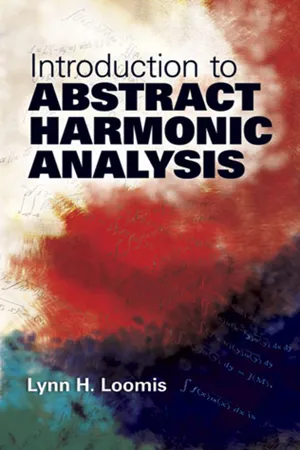
- 208 pages
- English
- ePUB (mobile friendly)
- Available on iOS & Android
Introduction to Abstract Harmonic Analysis
About This Book
This classic monograph is the work of a prominent contributor to the field of harmonic analysis. Geared toward advanced undergraduates and graduate students, it focuses on methods related to Gelfand's theory of Banach algebra. Prerequisites include a knowledge of the concepts of elementary modern algebra and of metric space topology.
The first three chapters feature concise, self-contained treatments of measure theory, general topology, and Banach space theory that will assist students in their grasp of subsequent material. An in-depth exposition of Banach algebra follows, along with examinations of the Haar integral and the deduction of the standard theory of harmonic analysis on locally compact Abelian groups and compact groups. Additional topics include positive definite functions and the generalized Plancherel theorem, the Wiener Tauberian theorem and the Pontriagin duality theorem, representation theory, and the theory of almost periodic functions.
Frequently asked questions
Information
Chapter I
______________
TOPOLOGY











Table of contents
- Cover Page
- Title Page
- CHAPTER I: TOPOLOGY
- CHAPTER II: BANACH SPACES
- CHAPTER III: INTEGRATION
- CHAPTER IV: BANACH ALGEBRAS
- CHAPTER V: SOME SPECIAL BANACH ALGEBRAS
- CHAPTER VI: THE HAAR INTEGRAL
- CHAPTER VII: LOCALLY COMPACT ABELIAN GROUPS
- CHAPTER VIII: COMPACT GROUPS AND ALMOST PERIODIC FUNCTIONS
- CHAPTER IX: SOME FURTHER DEVELOPMENTS
- Bibliography
- Index
- Back Cover